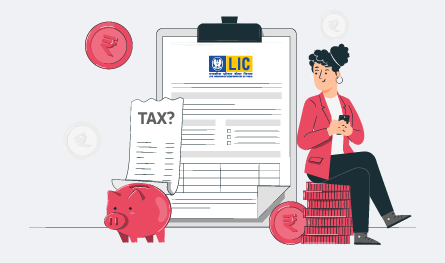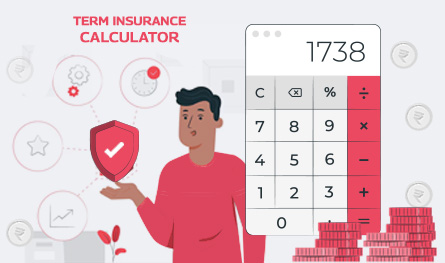Is LIC Maturity Amount Taxable or Not? Know LIC Maturity Amount Taxable under Which Head?


- What is the Maturity Amount?
- New CBDT Circular on Calculating Tax-Exempted Maturity Amount of Life Insurance Policies
- What do you mean by LIC Maturity Amount?
- What is the LIC Maturity Benefit?
- LIC Maturity Amount is Taxable or Not – What Tax Implications are levied on LIC Maturity Benefit?
- Conditions Under Which LIC Maturity Amount is Taxable
- Conditions Under Which the LIC Maturity Amount is Not Taxable
- Top LIC Plans 2024
- How is the tax-exempt portion of life insurance plans going to be calculated?
What is the Maturity Amount?
Maturity amount is the sum of money received by a life insurance policy holder at the end of a policy term in case he/she survives the plan. Let us find out if the LIC maturity amount is taxable or not, in this post.
New CBDT Circular on Calculating Tax-Exempted Maturity Amount of Life Insurance Policies
The Central Board of Direct Taxes (CBDT) issued a circular on August 16, 2023. The circular states the new guidelines on calculating the tax-deducted life insurance maturity amount in a financial year if the premium paid by the insured goes beyond a particular margin.
As per the new guideline, policyholders will not enjoy fully exempted maturity amounts from life insurance policies that were purchased on or after 1st April 2023. If a policyholder is paying a premium that is beyond INR 5 lakhs in a financial year, the individual will have to pay tax on the maturity amount of the policy. The rule applies to all life insurance policies with the exception of ULIPs. As per the new rule, the policies issued till March 31, 2023, will continue to enjoy tax-free status for the maturity amount.
In the case of ULIPs, the maturity amounts are taxable for policies purchased on or after 1st February 2022 if the premium paid by the insured exceeds INR 2.5 lakhs in a financial year.
Below are the criteria that need to be met for the proceeds from the life insurance policy to be taxable:
- a) The maturity amount received from a life insurance policy will be taxed if the premium paid by the insured in the preceding years surpasses INR 5 lakh.
- b) The maturity amount received from multiple life insurance policies will be taxable if the collective premium paid in the preceding years surpasses INR 5 lakh.
What do you mean by LIC Maturity Amount?
Life Insurance Corporation (LIC) of India pays a policyholder a sum of money as maturity benefit at the end of the policy term if the insured outlives the policy tenure. This amount is generally equal to the sum assured of the insurance policy at the time of maturity together with bonuses.
The proceeds of life insurance policies, including death and maturity benefits, allow tax benefits. However, there are some limitations in terms of liability to taxation that everyone should be well aware of. In this post, we will discuss if the LIC maturity amount is taxable or not and other details.
What is the LIC Maturity Benefit?
Let’s understand LIC maturity taxability by means of an example. Suppose you bought a life insurance policy of INR 10 lakh as sum assured for 10 years tenure. Now, when your tenure ends and if you outlive the policy period, LIC is likely to pay you the complete sum assured. This amount is called the maturity benefit.
There are some plans which allow an enhanced sum assured in the form of additional bonus earned through various guaranteed additions as well as loyalty accumulations. This boosts the maturity amount of the LIC policy. However, do you know if the LIC maturity amount is taxable?
LIC Maturity Amount is Taxable or Not – What Tax Implications are levied on LIC Maturity Benefit?
The total sum assured received as maturity benefit for surviving a life insurance policy of LIC is tax-free including the bonus as per section 10(10D) of IT. However, there are some eligibility criteria or conditions that need to be fulfilled to enjoy the tax-free maturity. Here, the sum assured of the life insurance policy and the premium amount is required to be in a particular ratio.
Let’s take a look at the different conditions of taxability of life insurance maturity amount of LIC.
Conditions Under Which LIC Maturity Amount is Taxable
Below are the conditions under which the maturity amount of LIC insurance policies are taxable –
- If the sum assured of the policy is coming from a Keyman Insurance. In a keyman insurance policy, an employer gets the insurance of their employees done and also receives the claim benefit
- If the nominee of the policy dies before the insured due to any already existing disability
- If the life insurance policy is bought under the name of an individual who had a disability, then the maturity amount received from the LIC policy is taxable
- If the policy is in the name of a person suffering from a particular disease that is mentioned under section 80DDB, the maturity amount received from the policy is taxable
- If you pay 20% more insurance premium in a year as compared to the Sum Assured for a policy bought on or after April 1, 2003, your maturity amount is taxable
- Also, if you pay 10% or more premium in a year as compared to the Sum Assured for a policy bought on or after 1st April 2012, your maturity benefit is taxable
For example, if you buy a life insurance policy from LIC of India with a coverage amount of INR 10 Lakh, your annual premium should be less than INR 1 Lakh to enjoy tax-free returns.
So, the maturity benefit in the above mentioned cases is added to the annual income of the insured and tax is levied on the total amount as per the tax slab that is applicable. In addition, the entire maturity benefit is levied with a 1% TDS, which is deducted from the amount before paying it to the insured by the insurer.
Conditions Under Which the LIC Maturity Amount is Not Taxable
Apart from the conditions mentioned above, the maturity amount in the rest of the conditions come under the category of entirely tax-free.
- If you pay a premium which is within 10% of the sum assured under a life insurance policy bought on or after April 1, 2012, you can enjoy full exemption of tax from the maturity amount.
- Likewise, if the premium paid is within 15% of the sum assured for a life insurance policy bought for a disabled individual on or after April 1, 2003, the maturity benefit is tax-free
- Also, if the premium paid is within 20% of the sum assured for policies purchased on or after April 1, 2003, the maturity amount is tax-free
Let us take a look at some of the top life insurance plans offered LIC of India below.
Top LIC Plans 2025
Now that you know about tax-free benefits on LIC policy maturity, below are some of the popular LIC life insurance plans to invest in:
| LIC Policy | Plan Type | Entry Age | Term of Policy | Maturity Age | Sum Assured |
| LIC Tech Term Plan | Term Insurance | 18 to 65 years | 10 to 40 years | 80 | INR 50 lakh – no limit |
| LIC Jeevan Amar | Term insurance | 18 to 65 years | 10 to 40 years | 80 | INR 25 lakh – no limit |
| LIC Jeevan Umang | Whole life + Endowment plan | 90 days to 55 years | 100 years minus the entry age | 100 | INR 2 lakh – no limit |
| LIC New Jeevan Anand | Endowment plan | 18 to 50 years | 15 to 35 years | 75 | INR 1 lakh – no limit |
How is the tax-exempt portion of life insurance plans going to be calculated?
As per the CBDT guidelines, individuals can opt for life insurance policies offering higher maturity amounts for tax benefits.
Here is an example as per the CBDT circular to show how tax benefits for the maturity amount of life insurance policies are calculated if the premium in the preceding years of the policy term surpasses INR 5 lakh.
| Life insurance plan | A | B | C | D |
| Policy issue date | 1st April 2022 | 1st April 2023 | 1st April 2023 | 1st April 2023 |
| Premium (Paid annually in INR) | 5-lakh | 1-lakh | 3.5-lakh | 6-lakh |
| Sum Insured (INR) | 50-lakh | 10-lakh | 35-lakh | 60-lakh |
| Maturity amount on 1st Nov. 2032 | 60-lakh | |||
| Maturity amount on 1st Nov. 2033 | 12-lakh | 40-lakh | 70-lakh |
In the table above, you can see that the life insurance maturity amount for policy A will enjoy tax exemption status since it was issued before April 1, 2023. However, other policies purchased on or after April 1, 2023, need evaluation to compute the tax-exempt percentage.
The maturity amount received from policies B and C also enjoys tax-exemption status because the combined yearly premium does not surpass INR 5 lakh in a year. However, the maturity amount of policy C will be taxed since the premium paid annually surpasses INR 5 lakh.
FAQs: Is LIC Maturity Amount Taxable or Not?
Yes, LIC allows tax exemptions under section 80C on life insurance policies. If the policyholder has bought a life insurance policy on or before March 31, 2012 for him/herself or for spouse, child etc., he/she can get up to 20% of tax deduction on the premium.
To claim deduction on the premium of life insurance policy, you can file under section 80C. For individuals, tax exemption can be availed if the policy is bought in the name of taxpayer, spouse or children.
If you have purchased your life insurance plan after 1 April, 2012, and the premium you are paying annually is more than 10% of policy sum assured, the maturity benefit would be taxed under section 10 (10D) and as per your income slab. Else, you can enjoy tax-free maturity.
The maturity amount can be claimed at the branch office of your LIC policy. In fact, the branch will send a letter to the policyholder two months prior to the date of the maturity informing the details of the payment to be received.
Yes, death benefit for term plans as well as permanent life insurance plans that is received by the nominee of the plan is tax- free.
Once your life insurance policy reaches maturity, you get the maturity benefit as a lump sum amount paid by the insurer. For example, if the life insurance plan has a 20 year term, the insured will get the maturity benefit at the end of 20 years if he/she outlives the term of the policy.

Author Bio
Paybima Team
Paybima is an Indian insurance aggregator on a mission to make insurance simple for people. Paybima is the Digital arm of the already established and trusted Mahindra Insurance Brokers Ltd., a reputed name in the insurance broking industry with 17 years of experience. Paybima promises you the easy-to-access online platform to buy insurance policies, and also extend their unrelented assistance with all your policy related queries and services.
Other Life Insurance Products
Latest Post

If you think of life insurance, chances are you are picturing something people buy in their 30s or 40s. But what if you are 65 or older and just getting started? The good news is that you are never too late. Whether you are thinking of easing the financial burden on your family, covering final expenses, or simply leaving behind a legacy, there are life insurance options tailored just for you.
This article will be a guide to life insurance for senior citizens above 65 years, explaining why it is important, the type of insurance options, and how to get the right policy for you.


Have you ever caught yourself lost in illusions about your daughter's future events, such as her university convocation and first day at work? Her university convocation. When she embarks upon her initial job after graduation will be the day.


Let’s be honest – life insurance planning isn’t exactly someone’s weekend hobby. It is the financial equivalent of flossing: we understand its importance, but we tend to put it off. But somewhere between balancing work and life, you might realise you need to have a solid plan in place – just in case.


We all know that health insurance policies offer a long list of inclusions. However, exclusions are also a crucial aspect of every policy. Overlooking policy documents can surprise you with hidden clauses that you didn't even know existed. To avoid such unpleasant situations and unexpected expenses during medical emergencies, it is crucial to uncover hidden clauses your health insurance policy may contain. When you buy health insurance online, make sure to know all about the policy before signing the document.
From least known exclusions to waiting periods and conditions in the fine print, hidden clauses can affect your overall experience. To help you out, here are the top hidden clauses of a health insurance policy that you should know.

.png)
Lymphocytes, a kind of white blood cells, are an extraordinary army of defenders functioning in the bustling world of our immune system for our body’s immune defence. Let’s know about these mighty warriors who are continually waging war against invading pathogens, viruses, and microbes in detail.




